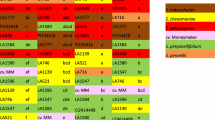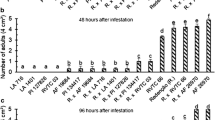Summary
In comparisons made under typical summer conditions in the field at Davis, California, the foliage of the anthocyanin-deficient mutant af proved to be much more susceptible to attack by Epitrix hirtipennis (Melsheimer) than that of the isogenic normal line, normal cultivars, or any other tested mutant. Since a relatively uniform level of damage was observed in leaves of various ages that contacted the soil, the interaction is probably of a preference rather than antibiotic nature. A comparison with nine other anthocyaninless mutants proved that anthocyanin deficiency is not responsible for susceptibility. The severe reduction of glandular hairs and consequent lack of foliage aroma—hitherto unsuspected pleiotropic effects of af—probably account for the high susceptibility of this mutant. The evolutionary significance of the distinct foliage aromas characteristic of each tomato species is discussed.
Similar content being viewed by others
References
Burdick, A. B., 1958. New mutants. Rep. Tomato Genetics Coop. 8: 9–11.
Clayberg, C. D., 1971. Report of the gene list committee. Rep. Tomato Genetics Coop. 21: 2–10.
Gentile, A. G. & A. K. Stoner, 1968a. Damage by larvae of the tobacco flea beetle to tomato seedlings. J. Econ. Entomol. 61: 152–154.
Gentile, A. G. & A. K. Stoner, 1968b. Resistance in Lycopersicon spp. to the tobacco flea beetle. J. econ. Entomol. 61: 1347–1349.
Lyon, D. J. deB., 1970. Flea beetle attack on glandless cotton in Nigeria. Empire Cotton Grow. Rev. 47 (3): 198–202.
Painter, R. J., 1951. Insect resistance in crop plants. MacMillan, N. Y.
Quiros, C. F. & D. Hughes 1975. A technique for the capture of foliage volatiles in the tomato species. Rep. Tomato Genetics Coop. 25: 15–17.
Stoner, A. K., 1970. Breeding for insect resistance in vegetables. HortScience 5 (2): 76–79.
Thompson, A. E., 1955. Inheritance of high total carotenoid pigments in tomato fruits. Science 121: 896–897.
Tressl, R. & W. G. Jennings, 1972. Production of volatile compounds in the ripening banana. Agric. & Food Chem. 20: 189–192.
Wolfenbarger, D. A., 1966. Variations in leaf miner and flea beetle injury in tomato varieties. J. econ. Entomol. 59: 65–68.
Author information
Authors and Affiliations
Rights and permissions
About this article
Cite this article
Rick, C.M., Quiros, C.F., Harry Lange, W. et al. Monogenic control of resistance in the tomato to the tobacco flea beetle: Probable repellance by foliage volatiles. Euphytica 25, 521–530 (1976). https://doi.org/10.1007/BF00041587
Received:
Issue Date:
DOI: https://doi.org/10.1007/BF00041587




